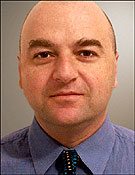CrossID, an Israeli startup founded by two engineers formerly at the telecommunications equipment provider RAD Group, has developed an innovative, chipless RFID system that can protect sensitive documents, such as intelligence agency reports, financial securities and banknotes. The technology could also be used to create a “hands-free” bar code.
The system uses “nanometric” materials—tiny particles of chemicals with varying degrees of magnetism—that resonate when bombarded with electromagnetic waves from a reader. Each chemical emits its own distinct radio frequency, or “note,” that is picked up by the reader, and all the notes emitted by a specific mix of different chemicals are then interpreted as a binary number. Since the system uses up to 70 different chemicals, each chemical is assigned its own position in a 70-digit binary number.
For example, if the chemicals A, B, C and D were assigned to the first, second, third and fourth positions in the 70-digit number, then a mixture consisting of A and C would represent the binary number 1010 followed by 66 zeros. CrossID is testing readers that operate at three to 10 GHz, which is higher than the frequencies commonly used by wireless LANs and handheld computers, although the company has not made a final determination on what frequency the readers will use.
The tiny chemical particles can be embedded in or printed on paper. Readers can be placed inside copy machines to prevent unauthorized copying. One application would be to require that any document printed on CrossID’s special paper be photocopied onto the same type of paper. That way, an intelligence agency, financial institution or even a company wanting to protect its intellectual property could install readers at building exits to prevent unauthorized people from copying documents and leaving the building with them.
“Previously, there has been no way to protect paper documents,” says Moshe Glickstein, who cofounded CrossID with Michael Shafir. “We have created the first firewall for paper documents.”
The technology is similar to a system developed by Inkode. The Inkode system randomly embeds tiny aluminum fibers in paper or packaging and then interprets the reflected signal (see 1-Cent RFID Tags for Supermarkets). Like Inkode, CrossID’s technology can be used for applications beyond just protecting documents. It can be used for anticounterfeiting and tracking of goods.
Glickstein says CrossID’s big advantage is that the tag can be printed on just about anything. “Because it’s printable, it does not complicate the process of producing the product,” he says. “It’s as easy to create as a printed bar code. And we can print in invisible mode for extra security. Printing the tags cost less than 1 cent each.”
Glickstein envisions companies using CrossID ink to print bar codes representing a product’s stock-keeping unit (SKU) number or unique EPC number, with the printer applying a specific chemical mix corresponding to the number being printed. Once a product’s bar code is printed using CrossID ink, a company could scan the bar code from 10 feet away, without a line-of-sight requirement. In environments where there are lots of metallic or water-filled objects, however, CrossID readers may not be able to scan bar codes printed with CrossID ink because metal reflects RF signals and water absorbs them (conventional RFID systems have the same issues).
But the CrossID system has the advantage of being able to work with existing bar code systems. Companies using the system, therefore, do not have to do major upgrades to their application software and databases. Instead, they can just match the CrossID number gleaned from the resonating ink to the existing bar code number.
CrossID has built a laboratory prototype reader and proved the concept. It is now in the process of raising $15 million in funding to create its first commercial products. Glickstein says that by the end of the year, the company should have its document-protection system ready. A year after that, the system for printing bar codes should be commercially available.


